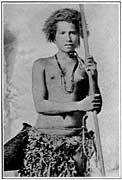 |
"A fisher girl" Frontispiece Caption reads " gazing sadly seaward and praying that her lover in the turtle fleet may escape the horrible penalty exacted from thos who fail to make the catch demanded by the Ratu. Photo by J.H.Walters, Suva." The "horrible penalty" is spelled out in the final caption on this page. The girl is leaning on what appears to be the pole for poling a takia canoe in shallows, called i-kara, She wears a work-girdle called i-suai roughly-made of banana leaves (well-made ones, called liku, took many days to weave, and would be ruined by going in the sea), and on her hip is strapped a noke coconut-leaflet basket for putting fish into. |
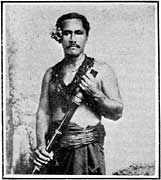 |
"A lotu or Christian Fijian of the present day" p. 32 Caption reads: "His short hair and sulu, or waist-cloth, show his renunciation of cannibalism. Photo by J.H.Walters, Suva." |
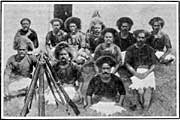 |
"Fijian Armed Native Constabulary" p. 32 Caption reads: "in sulu or kilts. The contingent at King Edward's Coronation [1902] were for a few days with the Gordons at Aberdeen, whom they regarded as kai vata, or relations, on account of the kilt." |
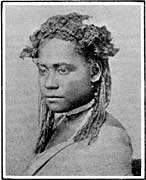 |
"Girl with tombe [tobe] or love-locks" p. 40 Caption reads "These locks are a mark of virginity, cut off after marriage. The jealous Tavua men shore off those of their maidens who flirted with the men from Nadarivatu. Photo by J.H.Waters, Suva." |
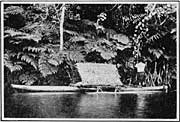 |
"A takia or light-draught canoe" p. 40 Caption reads "Used on the headwaters of the Viti Levu rivers. The valevale or little thatched house, protects the travellers from sun and rain." This is the same picture as "Upper Navua River" on p.97 of the Cyclopedia of Fiji. See comments on that webpage. The type of boathouse is also illustrated in a postcard of "Houseboats on the Rewa River" on this website, in that case built on bamboo rafts. |
|
"Tinga [i-tiqa] throwers" p. 64 Caption reads: "The annual game played at the sprouting of the yams. The reeds used have hard wood heads, called ulutoa,* a relic of ancient phallic worship." [*a name deriving from ulu, meaning head, and toa, an archaic word for Casuarina, today nokonoko, a very hard wood] For further discussion of this game of veitiqa, see Ewins, Rod. 2010. "The perils of ethnographic provenance; the documentation of the Johnson Fiji collection in the South Australian Museum (Chapter 3)". In Hunting the collectors; Pacific collections in Australian museums, art galleries and archives (Revised and reprinted), ed. Cochrane, Susan and Max Quanchi. Cambridge: Cambridge Scholars Publishing. pp. 31-65 |
|
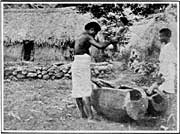 |
"Lali or wooden drum" p. 64 Caption reads: Formerly used as calls to war, cannibal feasts and to signal movements of the enemy, etc. Now, like our own bells, they summon people to church. |
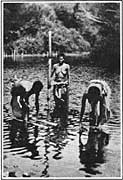 |
"Filling the water pots" p. 160 Caption reads: "Hill women with bamboos [bituniwai], emblematic of their sex, drawing water from the river." |
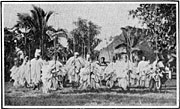 |
"A wesi or spear dance" p. 208 Caption reads: "Second from right, front row, is Ndavelevu [Davelevu], the old Nasongo [Nasogo] chief, who strangled his mother. From a photograph by Sir John Thurston [sometime Governor of Fiji]" The great looped flounces of white bark-cloth that the men are wearing suggests that these may have been people of Rewa, who wore ceremonial cloth in that way. Note that several of the dancers are also wearing white hairscarves [i-sala], signs of chiefly status, though interestingly Davelevu is not. |
 |
"A cannibal hill warrior" p. 224 Caption reads: "A Tholo [Colo], or Hill Warrior, of Viti Levu, in the garb of ancient Fiji. His unshorn locks and scanty dress of malo, or masi, denote that he is still a tevoro or cannibal. Photo by J.H.Waters, Suva." In this posed studio picture, the "unshorn locks" are in fact a wig. It is true that when men converted to Christianity it was demanded that they assume the wrap-around sulu shown on the lotu above. This was a matter of difficulty for the men, who at that time considered the sulu a female garment, and wearing it an affront to their manhood. The man wears a magnificent wasekaseka necklet of split whale-teeth (bati ni tavuto, also used as presentation tabua), and in his right hand carries a war-fan, in his left a barbed spear of the gadregadre form. |
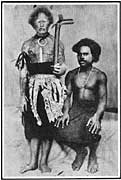 |
"A Fijian albino" p. 224 Caption reads: "The Ndala [Dala] clan, on whose domains the Hill Station of Nandarivatu [Nadarivatu] was built, had a legend that as long as there was an albino in the tribe they would retain possession of their tribal lands. Photo by the late W.C.Reay, Esq., District Commissioner, Fiji." The albino [rea] in this photo is dressed as a warrior. He has a boar's tusk necklet, wears a liku waloa or black "grass" skirt with an overskirt that appears to be strips of white barkcloth [masi], and around his waist wears a cummerbund of the black barkcloth made by the men of the Colo highlands. He carries a kiakavo common or footsoldier's club (often incorrectly called a gunstock club). The seated man is dressed in the i-sulu of a lotu or Christianised Fijian. |
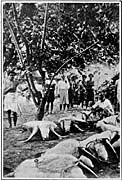 |
"A satisfactory catch." p.256 Caption reads: "Freeing the fishers of the Ratu's turtle fleet from the dreadful alternative." The "dreadful alternative" is spelled out in the final caption on this page. |
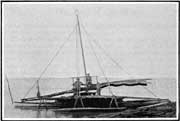 |
"A typical ishing canoe" p. 288 Caption reads: "The halliards are passed through the crutch at the masthead." |
 |
"The flagship of the turtle fleet" p.288 Caption reads: "The Tunindau [Tunidau] or Head Fisherman's canoe. He was responsible that each canoe should make a catch of ten turtles, or substitute any deficiency with human bodies for his suzerain the Ratu." |
